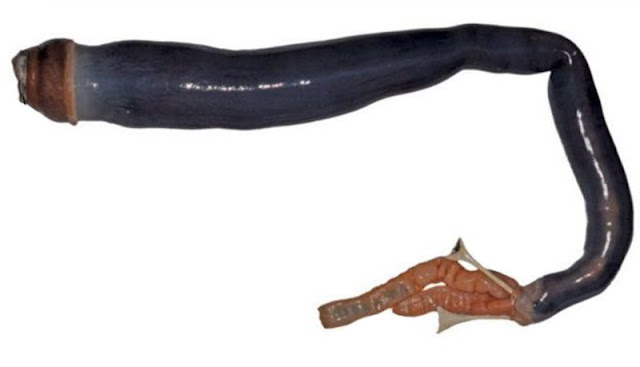They ought to stay, these beautiful, shy vaquitas (
Phocoena sinus), but the possibility of seeing them in our lifetime is immensely threatened. They are on the edge of extinction.
Vaquitas ("little cow" in Spanish), the world's smallest cetaceans, belong to the family Phocoenidae, the porpoises, which contains only 6 species worldwide. They can reach a length of up to 1.5 meters, and can only be found in Mexico's Gulf of California [1].
They live in murky, relatively shallow waters, feeding on various demersal and benthic fishes. Although they can be spotted in small groups, up to 10 individuals, they can be loosely aggregated across a wide expanse of water [2].
We are fascinated as we are intrigued by a dolphin's inherent "smile". Vaquitas are kindred to this anatomical configuration: with inward black lips and dark circles around their eyes, shaded like a mascara. Unlike delphinids which have conical teeth, porpoises have compressed, spatulate teeth [3].
While there used to be 567 individuals in the region (a best estimate in 1997) [2,4], a survey in November 2016 stated that there are only around 30 of them left - a staggering 95% decline in their population [4]. Left unprotected, the species may be forever gone by 2020 [7].
And we might lose them in exchange for soup.
Entangled for Too Long
The vaquita's population has always been precarious [9]. Often drowning from bycatch, the porpoise was decimated in 2015 by gill nets used to catch another critically endangered species, the totoaba (
Totoaba macdonaldi).
The fish, reaching 2 meters and weighing as much as 100 kg [5], is priced merely for its swim bladder which it uses for buoyancy [4,6]. The organ is remarkably reputed by the Chinese to cure many ailments and boost fertility - ultimately brewing as soup called fish maw [7].
Hunting for this enticing fish has been illegal since 1975. But, like drugs, the market holds too strong an incentive for this lucrative 'commodity', earning its title the "aquatic cocaine" [6]. The giant bladder - with its unusual 'tentacles' - bags around $10,000 each in Chinese black markets [7].
 |
| Totoaba's huge bladder is prominent with its two, dangling tentacles (Photo from CNN) |
In April 2015, the Mexican government enforced a two-year ban on all gill nets across the species' niche, covering 11,595 square kilometers [6]. Millions of dollars were spent compensating local fishermen not to fish in the region, along with regular military surveillance. Conservationists also participated in this huge endeavor to save the vaquitas in the wild [8].
Despite incremental efforts, the situation hit rock-bottom.
As the market for totoaba had only proved grueling, two more vaquitas, lifeless ashore, were spotted in March [9]. 59 individuals existed in 2015 but now a mere 30 breathe [4]. More recently, on the lookout for poachers, the Sea Shepherd group exposed hundreds of illegal gill nets ready to hunt the totoabas, ready to drown the vaquitas [9].
The ocean, its supposed sanctuary, has transformed into an inescapable trap. Omar Vidal, the CEO of WWF-Mexico, probably said it best: "We can still save the vaquita, but this is our last chance." [8].
The Audacious Plan
Some of the porpoises are bound to be rescued in October this year. The Mexican government has given US $3 million to the Vaquita CPR. Along with it, an international organization, Association of Zoos and Aquariums, donated $1 million [4].
Although acoustic data are available for preliminary detection, vaquitas are difficult to spot. They may wander alone or in pairs. Consequently, the plan to save them will rely on two US Navy trained dolphins to echo-locate their cetacean kin within the 2000 plus square kilometer home range [4]. However, scientists are concerned whether they can find them, let alone catch them without complications [9].
Also, scientists distill doubts in bringing them to captivity. The move poses high risks as no studies have been done to ascertain their survival [4]. They just don't know how the vaquitas will behave. And, even in the best of conditions, breeding in captivity is deemed unlikely to restore the population [9].
Still, some are hopeful that the plan could work [4]. Huge, dramatic measures will be considered in advance for the rescue. For instance, tissue culture can be secured for future studies. Also, veterinarians and captivity experts will board the mission and make certain that if vaquitas are stressed, the mission will be instantly called off. New plans will be conceived [6].
Saving the vaquitas remains to be an arduous battle. Securing them in a sanctuary may be the first bold step.
_________________________
[1] Palomares, M.L.D, & Pauly, D (eds). 2017. SeaLifeBase. World Wide Web electronic publication. www.sealifebase.org, version (02/2017).
[2] Rojas-Bracho, L., Reeves, R.R., Jaramillo-Legorreta, A., & Taylor, B.L. 2008.
Phocoena sinus. The IUCN Red List of Threatened Species 2008: e.T17028A6735464. Retrieved from http://bit.ly/2pzpE3i
[3] Berta, A. (Eds.) (2015).
Whales, dolphins, and porpoises: a natural history and species guide. University of Chicago Press.
[4] Nicholls, H. (2017, April 7). Last-ditch attempt to save world's most endangered porpoise gets go-ahead.
Nature. Retrieved from http://go.nature.com/2oMJBDn
[5] Froese, R., & Pauly, D. 2017. FishBase. World Wide Web electronic publication. www.fishbase.org, version (02/2017).
[6] Holman, J. (2017, April 12). Features: The race to save Mexico's vaquita from extinction.
AlJazeera. Retrieved from http://bit.ly/2oTZlnK
[7] Joyce, C. (2016, February 9). Chinese taste for fish bladder threatens rare porpoise in Mexico.
NPR. Retrieved from http://n.pr/1Kawdz5
[8] Bale, R. (2016, May 16). World's smallest porpoise is on the verge of extinction.
National Geographic. Retrieved from http://bit.ly/24UPdHX
[9] Malkin, E. (2017, February 27). Before vaquitas vanish, a desperate bid to save them.
The New York Times. Retrieved from http://nyti.ms/2l71NGZ





































